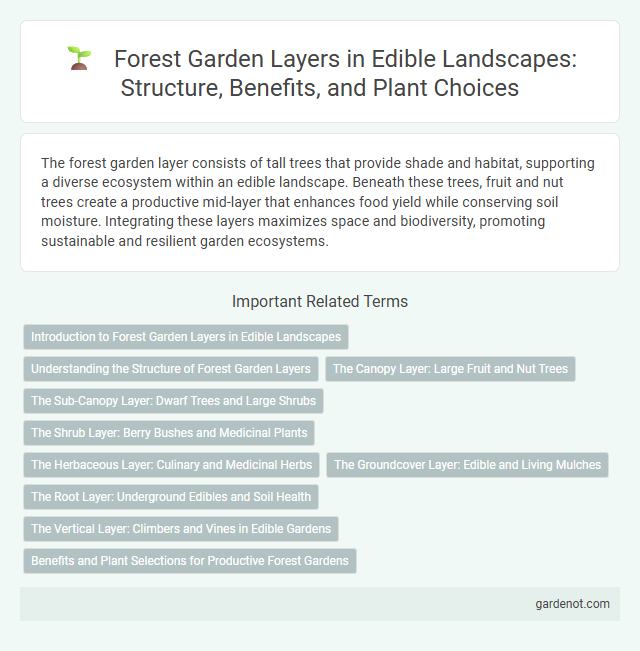The forest garden layer consists of tall trees that provide shade and habitat, supporting a diverse ecosystem within an edible landscape. Beneath these trees, fruit and nut trees create a productive mid-layer that enhances food yield while conserving soil moisture. Integrating these layers maximizes space and biodiversity, promoting sustainable and resilient garden ecosystems.
Introduction to Forest Garden Layers in Edible Landscapes
Forest garden layers in edible landscapes consist of seven distinct strata: canopy trees, low-tree layer, shrub layer, herbaceous layer, ground cover, root layer, and vertical layer. Each layer contributes to increased biodiversity, efficient land use, and enhanced food production by mimicking natural forest ecosystems. Integrating these layers creates a resilient, sustainable, and productive edible landscape system.
Understanding the Structure of Forest Garden Layers
Forest garden layers consist of seven key strata: canopy trees, low-tree layer, shrub layer, herbaceous plants, ground cover, root crops, and vertical climbers, each contributing unique ecological functions and food production. Understanding this multilayered structure enables efficient use of vertical space, enhanced biodiversity, and improved soil health in edible landscapes. Integrating diverse species within these layers maximizes yield while creating resilient, self-sustaining ecosystems.
The Canopy Layer: Large Fruit and Nut Trees
The Canopy Layer in a forest garden consists of large fruit and nut trees such as oak, chestnut, and walnut, which provide essential shade and habitat for lower layers. These towering trees maximize vertical space by producing high yields of edible nuts and fruits, contributing to biodiversity and ecosystem stability. Integrating drought-tolerant species in the canopy layer enhances resilience and supports long-term food security within edible landscapes.
The Sub-Canopy Layer: Dwarf Trees and Large Shrubs
The Sub-Canopy Layer in forest gardens consists of dwarf trees and large shrubs that thrive beneath the main canopy, providing diverse yields such as fruits, nuts, and medicinal herbs. Species like dwarf apples, hazelnuts, and elderberries maximize vertical space while enhancing biodiversity and soil health. These plants offer shade tolerance and support pollinators, creating a resilient, productive layer within edible landscapes.
The Shrub Layer: Berry Bushes and Medicinal Plants
Berry bushes in the shrub layer of a forest garden provide a rich source of vitamins and antioxidants while supporting local wildlife habitats. Medicinal plants such as elderberry and gooseberry contribute natural remedies and enhance biodiversity within the edible landscape. Integrating these shrubs promotes sustainable harvesting and encourages ecological balance by fostering pollinator activity and soil health.
The Herbaceous Layer: Culinary and Medicinal Herbs
The herbaceous layer in a forest garden consists of culinary and medicinal herbs that provide both flavor and healing properties, enhancing biodiversity and ecosystem resilience. Common plants include mint, thyme, chamomile, and comfrey, which attract pollinators and improve soil health through their root systems. Integrating these herbs supports sustainable food production and natural pest management within the edible landscape.
The Groundcover Layer: Edible and Living Mulches
The Groundcover Layer in a forest garden consists of low-growing edible plants that act as living mulches, enhancing soil fertility and moisture retention while suppressing weeds. These plants, such as strawberries, clover, and creeping thyme, provide a continuous harvest of nutritious foods and attract beneficial insects for pest control. Integrating diverse groundcovers creates a resilient ecosystem, improves soil health, and maximizes productivity in edible landscapes.
The Root Layer: Underground Edibles and Soil Health
The root layer in a forest garden consists of underground edibles such as root vegetables, tubers, and rhizomes that contribute to soil aeration and nutrient cycling. Plants like Jerusalem artichokes, sweet potatoes, and garlic enhance biodiversity while improving soil structure and microbial activity. Integrating perennial root crops supports sustainable soil health and increases overall ecosystem resilience in edible landscapes.
The Vertical Layer: Climbers and Vines in Edible Gardens
Climbers and vines form the vertical layer in edible forest gardens, maximizing space by utilizing trellises, fences, and tree trunks for growth. Key species include climbing beans, grapes, kiwi, and passionfruit, which provide high yields of nutritious fruits and legumes. This vertical integration enhances biodiversity, improves microclimate control, and supports efficient nutrient cycling within the garden ecosystem.
Benefits and Plant Selections for Productive Forest Gardens
Forest garden layers maximize productivity by mimicking natural ecosystems, improving soil health, and increasing biodiversity. Key plant selections include nitrogen-fixing trees like alder, fruit-bearing shrubs such as currants, perennial herbs like comfrey, and ground covers like wild strawberries that suppress weeds and retain moisture. These diverse layers provide continuous yields of food, materials, and habitat, enhancing sustainability and resilience in edible landscapes.
Forest garden layer Infographic

 gardenot.com
gardenot.com